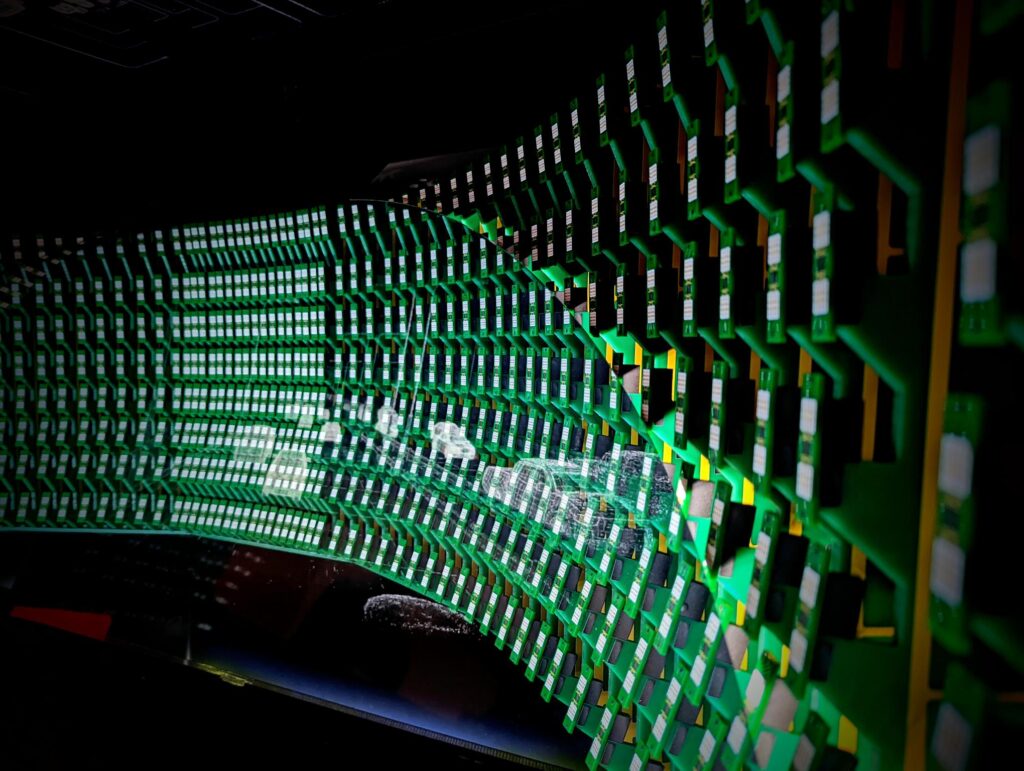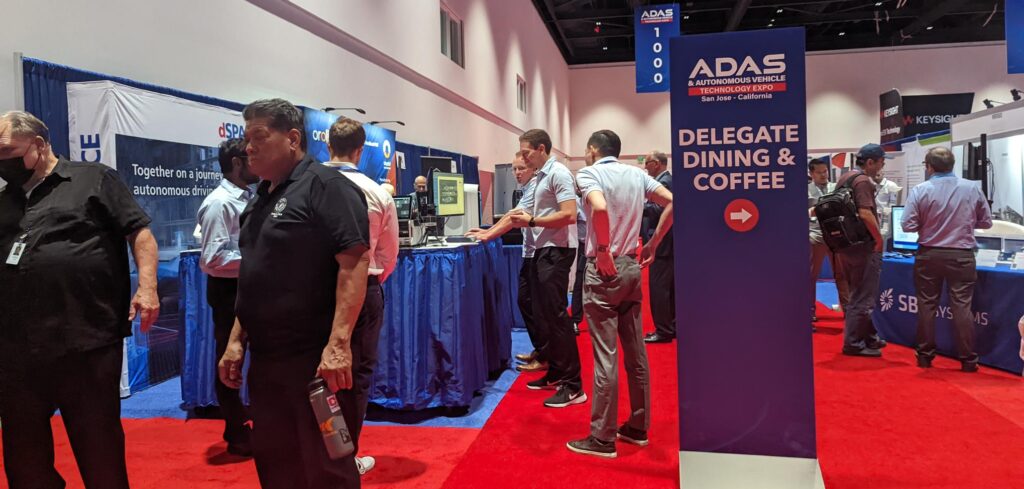ADAS & Autonomous Vehicle Technology Expo is in full swing at the San Jose McEnery Convention Center in California (September 7 & 8, 2022), where exhibitors are currently showcasing the latest technologies to enable and accelerate end-to-end autonomous and ADAS applications, including testing tools, simulation, software, sensing and AI. There are award-winning and groundbreaking innovations across the exhibition hall, including the latest from LeddarTech, MD Elektronik, Technica Engineering, Dewesoft and rFpro…
Raw-data sensor fusion and perception, and lidar enabling solutions
LeddarTech is showcasing its technologies for ADAS and AD, namely LeddarVision, its raw-data sensor fusion and perception solution designed for OEMs and Tier 1s, and its automotive lidar enabling solutions for lidar developers and Tier 1s and 2s, LeddarSteer and LeddarEngine.
“The LeddarEngine is an SoC and software solution that prides itself on performance, flexibility and reliability,” explained Hannah Osborn, director of America sales and business development at LeddarTech, live on Day 1. “Strong capabilities in dynamic range handling, advanced signal acquisition schemes as well as crosstalk, noise and saturation management distinguish LeddarEngine. The solution proposes a modular software architecture that adapts to a wide range of integrations, including new lidar designs and retrofits. It empowers customers with supreme flexibility in engagement, offering four levels of integration to fit the customers’ particular development needs.”
Osborn continued, “LeddarSteer is a solid-state automotive-grade digital beam steering technology based on liquid crystals and polarization gratings. The solution is suited for both retrofit and new lidar development, and can work with and without MEMS and on a wide range of frequencies. What makes LeddarSteer unique is its on-the-fly performance adjustment capabilities, enabling a lidar to focus on different regions of interest depending on the driving situation and on-demand resolution enhancement. Furthermore, LeddarSteer reduces the size, cost and complexity of the lidar, reinforcing why LeddarSteer is not a ‘nice-to-have’ but a ‘must-have’ for lidars.”
According to Osborn, “LeddarVision is a flexible, robust, cost-effective, sensor-agnostic and scalable auto-grade solution that delivers highly accurate 3D environmental models. In addition, the software supports all SAE autonomy levels by applying AI and computer vision algorithms to fuse raw data from sensors employed in L2-L5 applications designed for on-road and off-road vehicles.”
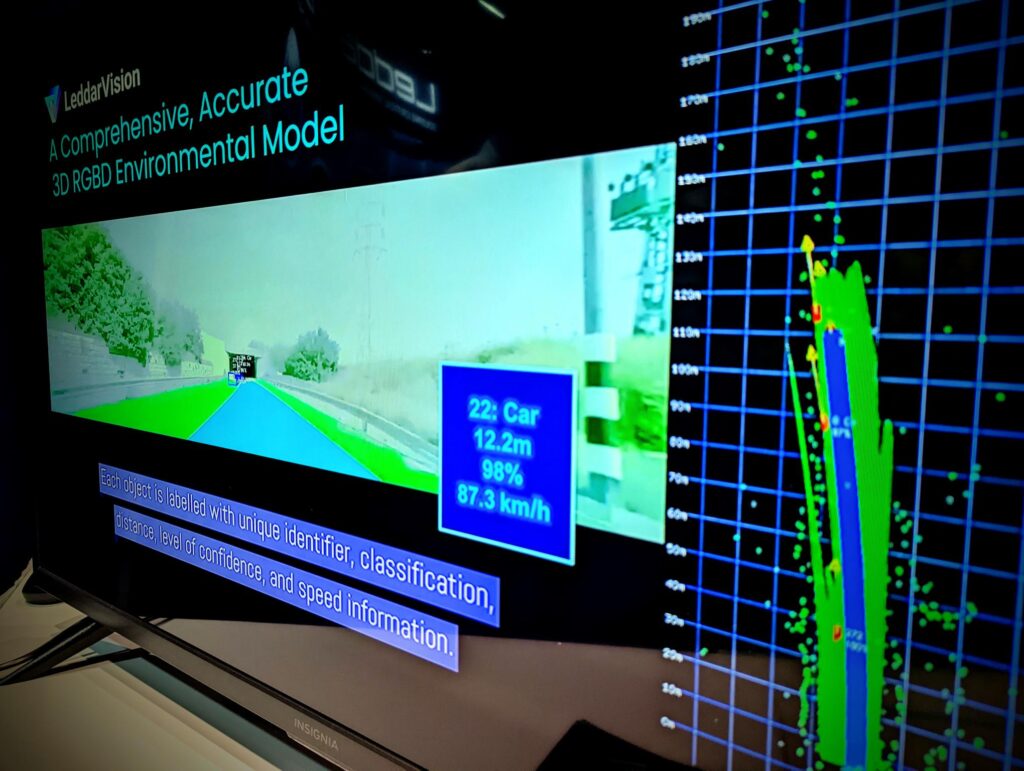
Data cable solutions for high-quality, reliable, real-time data transmission
Leading automotive data transmission specialist MD Elektronik is presenting its high-performance data cables and high-frequency wire harnesses, suitable for any technical requirement.
Autonomous vehicles require a high amount of sensor data from sources such as radar, cameras and lidar. The data must be transmitted from the sensor to the ECU at high speed to ensure that the vehicle knows its environment and the driving conditions. This demands innovative data cable solutions for the transmission of large amounts of data with high quality and reliability.
Growing numbers of ECUs (electronic control units) sharing real-time data on a much broader level are increasing the demand for more network bandwidth. The cables, connectors and cable assemblies are designed to meet the requirements of chipset manufacturers and IEEE standards. Furthermore, the manufacturing of the assemblies plays a crucial role in the quality of the data connection. Highly automated processes, small mechanical tolerances and quality checks ensure reliable connections with 360° shielding and EMC robustness.
However, with today’s gigabit bandwidth in an existing system, the requirements increase to a completely new architecture. MD has been working with Rosenberger and another connector supplier to manufacture connectors such as H-MTD and HSD to meet the demands for rapid data communication.
FAKRA (Fachkreis Automobil) is a former German automotive standard (now international ISO 20860) for automotive coax connectors. These connectors and the related assemblies work in harsh automotive environments and support frequencies up to 6GHz.
The mini coax connectors and cable assemblies combine all the advantages of a FAKRA system with a smaller package space and higher bandwidth up to 15GHz. FAKRA and mini coax support all high-frequency-based applications such as GPS/GNSS, 3G/4G/5G, car-to-X, surround view and data communication solutions in the Ethernet-coax area.
“The data connection of sensors and ECUs in the wire harness has an often understated but major impact on the network architecture of vehicles. Close cooperation between semiconductor, data transmission, wire harness and OEM experts is the key to a futureproof, innovative and reliable data transmission,” explained Gerd Mittermaier, MD Elektronik’s global vice president of R&D, live at the expo. “MD’s longstanding commitment to R&D and years of experience in data communication speed make us a reliable partner and ensure the suitable solution for your requirements.”
MD Elektronik says that ADAS & Autonomous Vehicle Technology Expo in California gives it a platform to detect mobility trends at an early stage and be one of the first companies to develop suitable solutions in very close contact with OEMs and technology drivers in the area of data transmission.
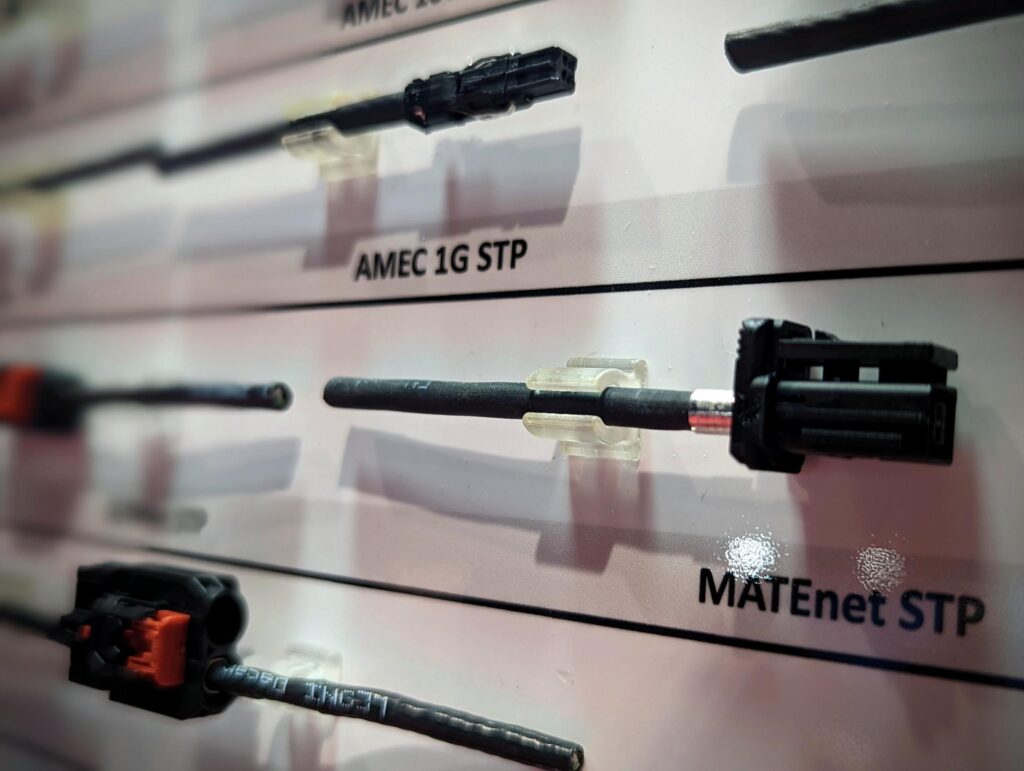
Automotive-grade, Enhanced Ethernet Switch with multiple ports
One of the highlights at Technica Engineering’s booth is its next-generation switch, otherwise known as the Enhanced Ethernet Switch (EES).
Since 2011, the Media Gateway has been Technica’s most successful hardware product. Now, in 2022, the company presents its successor product, the EES. The strength of both devices is that they are dedicated automotive-grade switches, able to handle multiple lines of automotive Ethernet.
The Media Gateway has been used in a large variety of automotive applications with its 12 ports of 100BASE T1. The EES provides eight ports for 1GigE automotive Ethernet, able to be used for both 100BASE-T1 and 1000BASE-T1 traffic. It is also equipped with two SFP+ ports, each allowing a data uplink of 10Gbps.
“The EES is the first automotive-grade switch with AVB and TSN functionalities, designed to meet important use cases in terms of time synchronization, traffic shaping, bandwidth reservation and gathering traffic from multiple Capture Modules,” revealed Anthony Morrone, COO at Technica Engineering. “It also fulfills the use cases of the Media Gateway, such as providing double-tagged VLANs, forwarding specific messages, or acting as a breakout box to log traffic between different automotive Ethernet ECUs. The switch supports TECMP protocol to allow seamless use of the EES together with Technica Engineering’s Capture Modules.”
According to Morrone, the EES can establish virtual point-to-point connections, using single-tagged VLANs (802.1q) and double-tagged VLANs (802.1q-in-q), thus enabling filter and control over data streams. Each port provides eight levels of quality of service priority classes and advanced traffic filtering capabilities with ingress and egress rules, which ensure the prioritization, resource reservation and control mechanisms over the data received. Through an internal configuration website or the remote-control API, users can easily configure the device for their use cases, abstracting the complex underlying switch hardware. This includes VLANs, port mirroring, forwarding, filtering, deep inspection through TCAM rules, port segmentation, handling of Jumbo Frames and many other features offered by Layer 2 switches. The Enhanced Ethernet Switch provides a reliable gPTP/802.1AS automotive profile stack for time synchronization that allows strong customization possibilities to adapt to any customer use case with time synchronization requirements.
The product is also capable of audio video bridging functions and can statically configure stream reservation and shaping features (802.1Qav).
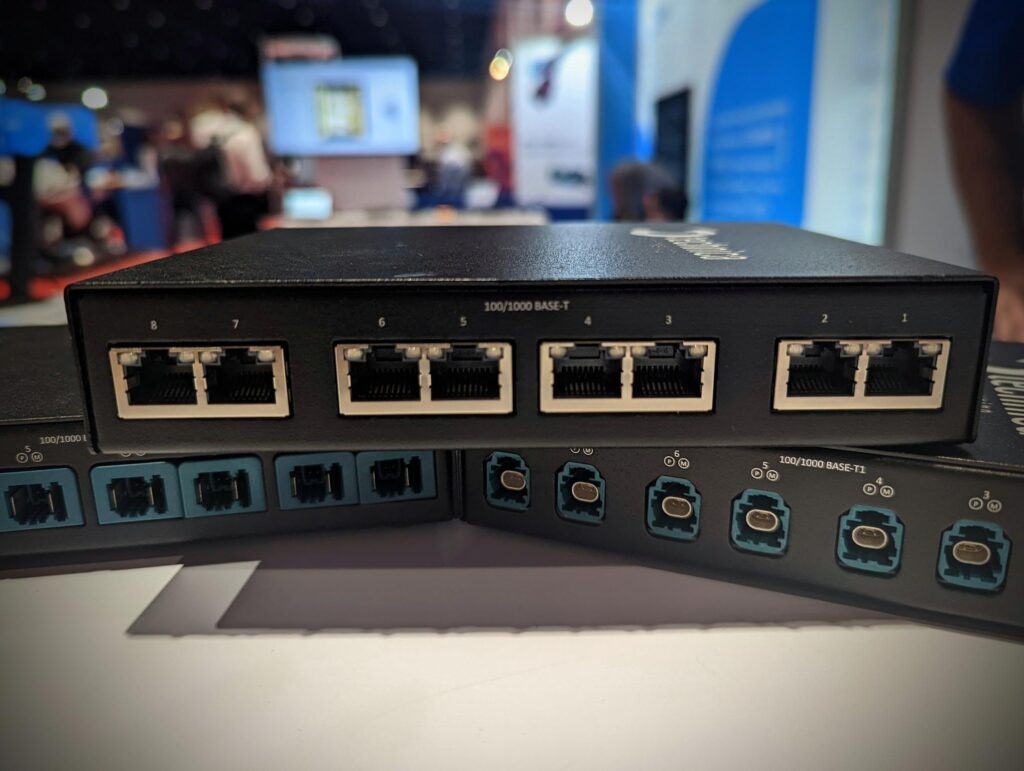
Highly accurate GPS for advanced positioning
Data acquisition specialist Dewesoft is showcasing its high-accuracy GPS that, in conjunction with correctional data from inertial measurement systems, provides exceptional correlation with indicated positions, both as absolutes as well as relational to objects within sensing proximities. This enables a greater degree of accuracy in respect of ‘tuning’ for the safest and most efficient implementation of ADAS.
“From a tuning perspective, the available systems/software offer referenceable real-time information that simplifies the entire process. When used in conjunction with peripheral optical devices a user can observe, again in real time, behaviors as well as relationships between observance and response,” explained Dave Gallop, business development manager ground vehicles/autonomous systems at Dewesoft, live at the expo. “This is also a basis for initial development and determination of zonal placements of sensors.”
Oftentimes, absolutes play very little part in GPS positioning, as ADAS is proportional and relative in regard to obstacles, especially since obstacles may well be in motion. However, an absolute reference provides exceptionally precise location data to ensure that testing is not subjected to deviations from the ‘host’ vehicle. When used and shared on multiple vehicles (multiple rovers) this can provide the user with very precise references regarding potentially unplanned deviations that may have occurred on other vehicles.
“Theoretically, it is possible to have numerous vehicles in a test network,” revealed Gallop. “This is typically unnecessary as behavioral characteristics can be drawn from subsets, which may involve only two or three. When used in the supporting polygon software, all obstacles and vehicles can be included, and peripheral image data can be overlayed to enhance the observation.”
He continued, “We chose ADAS & Autonomous Vehicle Technology Expo CA to present our GPS-based position measurement technology, primarily because Dewesoft is one of the few companies that offers a complete solution, from lidar interfacing to thermal monitoring on brakes at the same time and time aligned. Additionally, Dewesoft has placed more effort into the simplification of extremely complex analytical processes into a user interface that is both friendly, intuitive and feature-rich.
“Our company doesn’t just make the best measurement systems; it makes them usable. Our commitment to utilizing the very latest technology, offering the most accurate and reliable measurement systems is complemented by our drive to make them friendly and easy to master,” Gallop concluded.
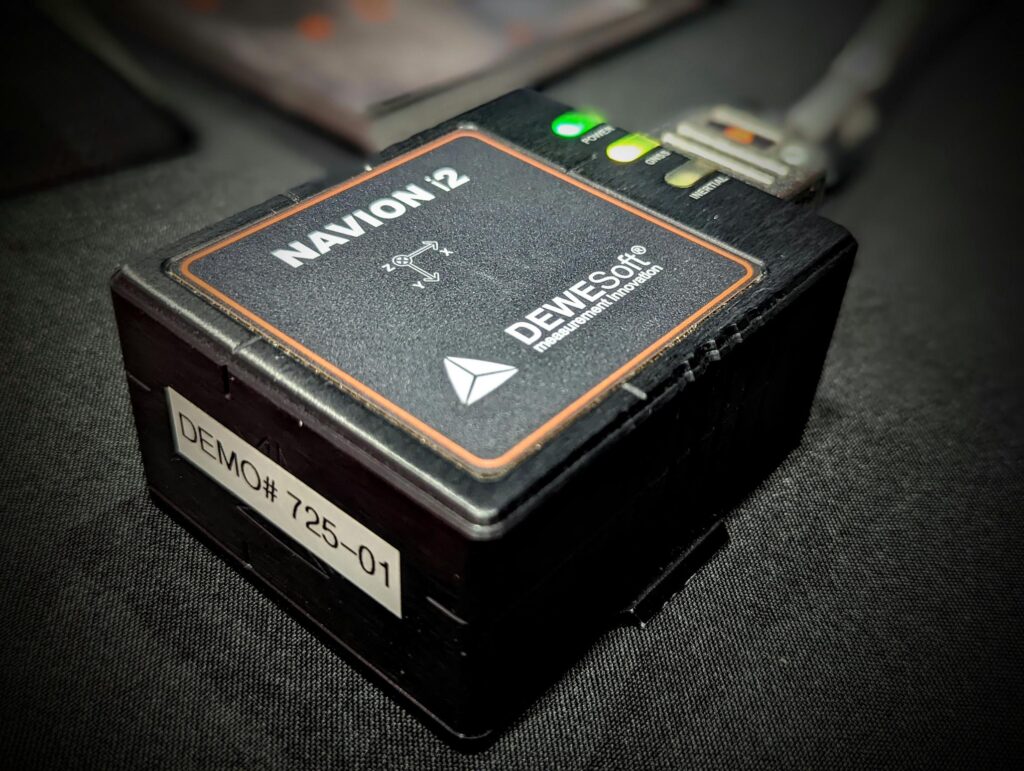
Groundbreaking simulation technique generates accurate, usable training data virtually
Visitors to rFpro’s stand are finding out about the company’s large-scale simulation technique, Data Farming, which enables vehicle manufacturers and sensor providers to generate complete training data sets virtually. According to operations director Matt Daley, it covers the full vehicle system where every sensor is simulated at the same time. The data is synchronized across all sensors, even with the most complex hardware designs. It is named after Render Farming, which has revolutionized the economics of popular animation.
“For the first time, vehicle manufacturers can build accurate, usable training data using simulation alone, thereby leaving real-world driving for correlation and validation,” emphasized Daley. “This means the generation of data, which is critical to AV development, can be massively scaled, limited only by the available computing power.
“Currently, many players in the autonomous vehicle field employ an army of people to manually annotate each frame of a video, lidar point or radar return to identify objects in the scene, such as other vehicles, pedestrians, road markings and traffic signals, to create training data. rFpro’s approach provides a digital, cost-effective way of creating the same data using engineering-grade simulation.”
Manual annotation takes around 30 minutes per frame with a 10% error rate. According to rFpro, its solution generates the same data 10,000 times quicker and is completely error-free.
“Data Farming will enable deep learning to fulfill its potential because it significantly reduces the cost and time of generating useful training data,” explained Daley. “It is estimated that an autonomous vehicle would need to drive 100 million miles to demonstrate that it is safe to use. This simply isn’t feasible in the real world but it is in simulation. Hundreds of thousands of simulations can be run overnight to subject AVs to an array of scenarios to support deep learning.”
He continued, “The ADAS & Autonomous Vehicle Technology Expo is one of the leading AV conferences in the world. Data Farming is set to revolutionize the development of autonomous vehicles and the conference is the perfect opportunity to inform the industry about it.”
Matt Daley spoke on Day 1 of the conference in a session titled ‘Accelerating autonomous vehicle development in the AI age: using simulation to produce high-quality synthetic data and propel your training and testing capabilities’.
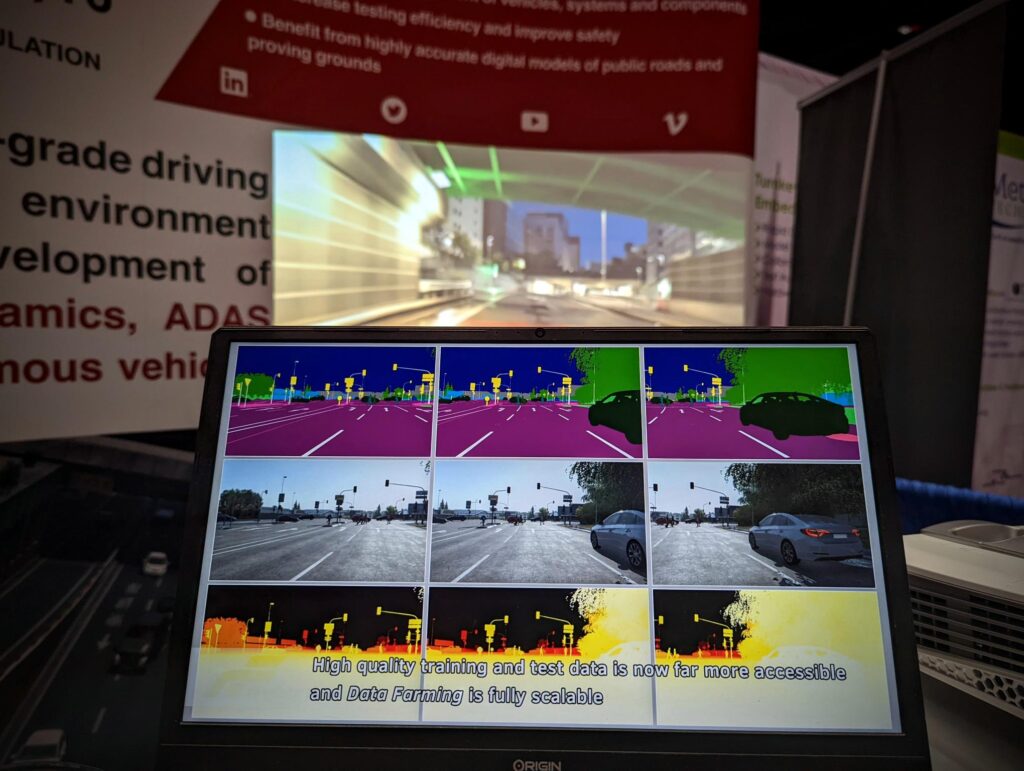
Radar scene emulation from Keysight Technologies boasts up to 512-pixel resolution
Keysight Technologies is demonstrating its award-winning radar scene emulation with sharpened vision.
Achieving the next level in vehicle autonomy demands robust algorithms trained to interpret radar reflections detected by automotive radar sensors. Keysight’s first-to-market technology combines hundreds of miniature radar target simulators into a scalable screen that can emulate objects with up to 512-pixel resolution and at distances as close as 1.5m. This breakthrough radar scene emulation (RSE) solution outshines conventional radar sensor test solutions that have a limited field-of-view (FOV) and cannot simulate objects at distances less than 4m.
Utilizing ‘total scene generation’, the radar scene emulation solution exercises automated drive systems and algorithms by applying time-synchronized inputs to the actual sensors. Its open architecture also closes the loop with existing hardware-in-the-loop systems and 3D modelers. These capabilities create a solution that complements – and fills the gap between – software simulation and on-road testing. As such, it overcomes the limitations of software simulation, which does not test real radar sensor response, while achieving repeatable testing of radar scenes, something that cannot be done on the test track.
The RSE enables users to emulate real-world driving scenarios, varying speed, distance and number of targets across a contiguous FOV. With radar sensors and back-end software confidently tested against the complexity of real-world driving scenarios, ADAS and next-generation vehicle autonomy can be achieved sooner, with less risk.
“Keysight’s Radar Scene Emulator is truly an amazing new product for autonomous vehicle testing,” said Steve Mango,Keysight Technologies’ automotive market industry manager, live on Day 1 of the show. “The RSE system lets you bring real-world driving scenarios into the lab where you can test and evaluate radar performance in a safe, repeatable and realistic environment. Many radar target simulators only allow for a few targets to be evaluated at one time, while the RSE can emulate an entire scene with up to 512 radar targets.”
Keysight’s RSE system has already been awarded the Tech.AD Europe Award for Best Project in Testing, Validation & Safety, the American Business Award for Achievement in Product Innovation 2022 and the Malaysia Technology Excellence Award 2022 for Automotive Hardware.
Aaron Newman, business development manager at Keysight Technologies, is speaking on Day 2 of the conference at 3:40pm, on ‘The gap between lab and road testing for radar sensing systems’.
